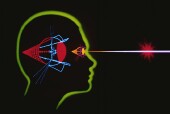
THURSDAY, Oct. 4 (HealthDay News) — Researchers have found a way to create a map of vision in the brain based on an individual’s brain structure, even for people who can’t see.
Among other benefits, this achievement could assist efforts to restore vision using a device that stimulates the surface of the brain, according to the University of Pennsylvania researchers.
For the study, the investigators used functional MRI scans to measure the brain activity of 25 people with normal vision and then identified a precise statistical relationship between the structure of the folds of the brain and the representation of the visual world.
“By measuring brain anatomy and applying an algorithm, we can now accurately predict how the visual world for an individual should be arranged on the surface of the brain,” study senior author Dr. Geoffrey Aguirre, an assistant professor of neurology, said in a university news release. “We are already using this advance to study how vision loss changes the organization of the brain.”
Co-lead author Noah Benson, a post-doctoral researcher in psychology and neurology, added: “At first, it seems like the visual area of the brain has a different shape and size in every person. Building upon prior studies of regularities in brain anatomy, we found that these individual differences go away when examined with our mathematical template.”
The study was published in the latest issue of the journal Current Biology.
More information
The U.S. Centers for Disease Control and Prevention has more about vision.

